The Calendar of the Yearly Festivals
118 118 Jūnisha Shrine
Kami Town Kasumi Ward Yoroi

Picture of the Kirin’s Head
Picture of the Shoujou’s Mask
| Date of the Festival | October-5 |
|---|---|
| Time for the Kirin Dance at the Shrine | No dance at the shrine (1:40 p.m. at the coast in Yoroi district) |
| Origin | Late Meiji era (1912) |
| Characteristics | The most remarkable features of this Kirin are its black head, decorated with thin ropes of zigzagged pieces of white paper, and the Shōjō's demon mask. The dance is originally from Iwami Town. |
| Area | Kami Town Kasumi Ward Yoroi |
Introduction to the Shrine
Jūnisha Shrine
The year of the shrine's founding is unknown. The shrine’s main hall was rebuilt in Enpō 4 (1676). It was made into one of the village’s shrines in October of Meiji 6 (1873).
■Deity of the Shrine
Amaterasu-Ōmikami, Gonan-sannyoshin, Izanami-no-Mikoto
■cultural property
[Kirin Dance]
Designated as a National Important Intangible Folk Cultural Property in 2020.
Access to the Shrine
Yoroi 584-2, Kasumi Ward, Kami Town, Mikata County, Hyōgo Prefecture(MAP)
A four-minute walk from Yoroi Station on the JR San'in Main Line.
Related Information
Sites Associated with the Kirin Dances
Monuments around the Tottori Station
-
Wooden Benches
-
Sand Sculpture of Kirin
-
Stone Sculpture of Kirin
-
Tottori Toshogu in the Ouchidani Park
Tottori Toshogu was established by Mitsunaka Ikeda, a local lord, in the 17th century, and is a branch shrine of Nikko Toshogu. The shrine inherits the initial Kirin, which is now stored in the Tottori Prefectural Museum. During Gongen Matsuri, a festival in October, members of the Inaba Kirin Dance Club dance before the shrine’s deity, and a procession of a mikoshi (portable shrine) walks through to animate the festival.
-
The Imeitei Pioneer Memorial Gallery of Hamasaka
Imeitei is a gallery remodeled by Shichikamaya Yashiki (Shichikamaya Mansion) of the Mori family, who until lately ran a sake-brewery. It is a historical and folk gallery where visitors can trace the footsteps of the pioneers living around the Shin-onsen Town. The head of the Kirin from the Utsuno Shrine is displayed in the gallery. It is designated as the town’s cultural heritage.
-
Sora no Eki Park (Sky Station Park) at the Amarube Bridge
The origin of the Kirin from the Junisha Shrine, a shrine in adjacent to the Yoroi district, is the Kirin dance performed in the Iwami Town. This dance was a part of the inauguration of the Amarube Bridge at the end of the Meiji period. Visitors can see children’s drawings of the Kirin displayed in Sora no Eki at the Amarube Bridge and the park at the foot of the Amarube Crystal Tower. The roadside stations in vicinity are also worth sightseeing.



